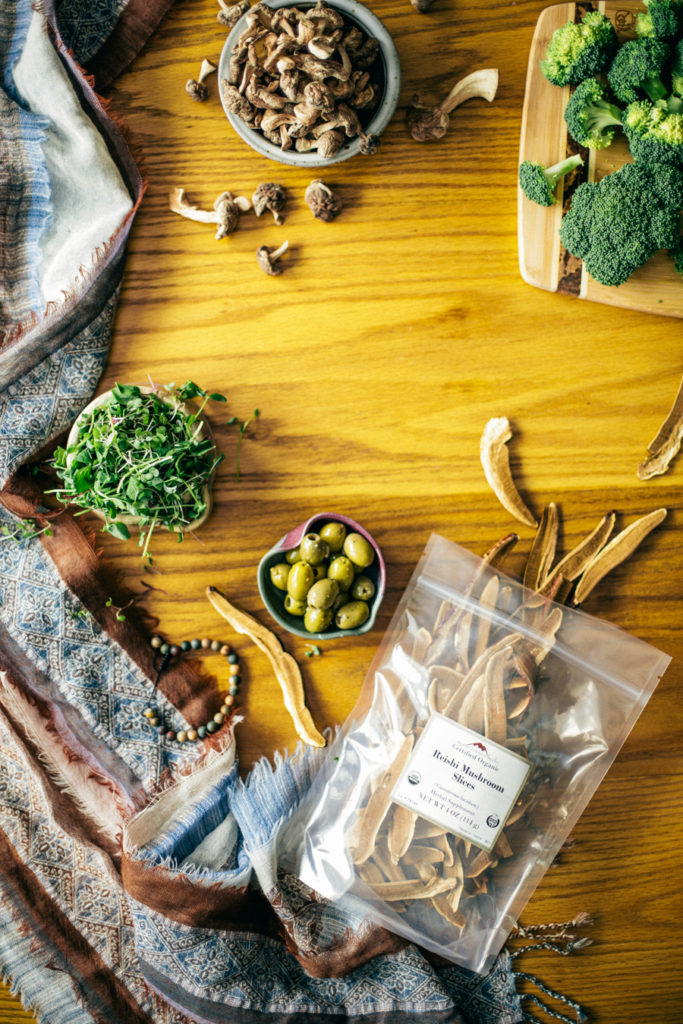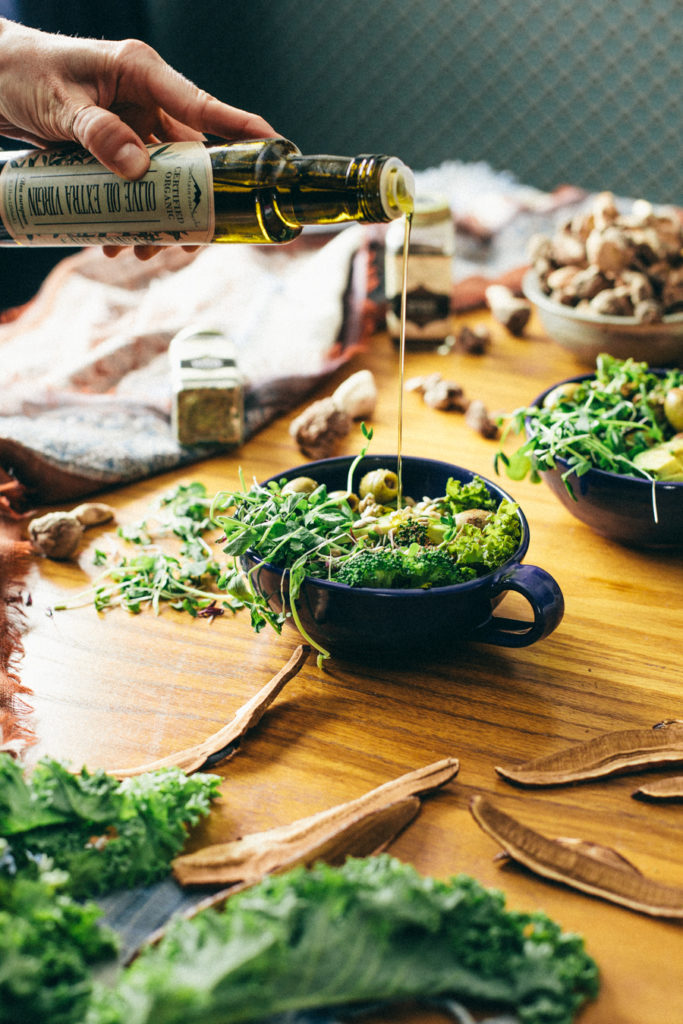
My favorite go-to meal in winter is hands down a “whatever’s in the fridge” savory buddha bowl. I’ve perfected about a dozen 20 minute messy buddha bowls that take so little effort and essentially clear out most of the lingering veggies in my refrigerator at the end of any given week. I make each one differently, but the base is usually the same: A whole grain, cooked in broth. Some roasted or steamed vegetables. A fresh veggie. Seeds. Something salty, brine-y, pickled or fermented. A drizzle of plant based oil. Protein. Herbs. Spices. Cheese (sometimes). Favorite bowl.
Winter is a time when most folks crave sugars and carbs. Makes sense – sugars and carbs both mean energy for the body. From an evolutionary perspective, finding a starchy sweet tuber or winter berries (treasures!) were totally prized because these provided the most storable form of energy for our seasonally imposed fasting and hungry body. Tubers and berries eventually turned into cravings for processed sugars and refined carbs as these are now readily available literally everywhere you go. Same foundational craving, but way less nutrient dense food choices.
Beating Sugar Cravings
One of the best ways to beat these cravings now? Load up on nutrient dense, whole grains and mineral rich foods in the winter months. This helps to keep us satiated and nutritionally balanced during the time of year when we have fewer fresh options. Buddha bowls are my favorite way to do this because they never get old. You can make these a dozen different ways every week and use whatever you have around to fill out your bowl. With every variation, add in different herbs and spices to change the flavors. Mountain Rose Herbs has a huge variety of high quality, incredibly delicious seasonings and herbs to create endless flavor combinations. My favorites are the garam masala and garlic pepper. I’m sprinkling these on everything I make lately, from scrambled eggs to broths, savory toast and crock pot soups.




Nutrition Tips for Winter
- Focus on energetic/seasonal shifting support. Winter is a time many of us go through a state of depletion. From the cold. From the holidays. From lack of fresh vegetables. It’s the time when colds, flu and bugs are everywhere. Including seasonal foods (and colorful foods!) in your diet is essential. Mushrooms are amazing for this time of year (including Reishi, shiitakes, oyster mushrooms, and chaga (sparingly). Also incorporating elderberry syrup this season is wonderful through the end of March.
- Hydrate, even when you don’t feel thirsty. Try to drink at least half your body weight in ounces daily, and herbal tea is an excellent way to do this. Ginger, dandelion root, CCF tea and herbal chai are some I recommend in winter months. My personal favorite piece of advice, make a cup of herbal tea part of your daily wardrobe.
- Consume at least 5 different colors every day. The more color you can consume in your foods = the more vitamins, minerals, nutrients and antioxidants. Buddha bowls easily accommodate five colors!
- Increase zinc rich foods in your meals. Zinc is an essential nutrient for our immune health, and it’s easily depleted in winter months with a limited (or processed) diets. Some options include legumes (chickpeas, lentils and kidney beans), seeds (sesame, hemp, pumpkin), organic red meats, shellfish, dark chocolate, whole grains (brown rice, quinoa, oats) and mushrooms (cooked).
- Keep at least 80% of your foods/meals cooked (vs raw). From an Ayurvedic perspective, consuming cooked and warming foods is ideal when the weather is cold and damp outdoors. This helps to keep our body in balance, and support overall digestion. I’m a huge proponent of this.
- Utilize warming herbs with every meal for circulatory support and stoking digestive fire. Ginger, cinnamon, cayenne, garam masala, curries, peppers and cardamom are ideal to sprinkle on meals to enhance the warming quality of your foods and stoke the digestive fire.
- Seasonal greens + bitters for digestive support. I love bitters all year long, but especially in the winter when our body can be sluggish from too much processed food, lack of exercise or increased stress. Bitters (and bitter greens like kale, collards and chard) are some of the best to consume to keep our liver strong and supported.
- Craving carbs? Try roasted root vegetables instead of processed carbohydrates. Roasted sweet potatoes, carrots, beets, squashes, turnips and parsnips, when roasted, release more sugars and satisfy the sweet/starchy craving in a much more nutrient dense way than consuming sugary breads. And they keep us satiated longer, too.
Buddha Bowl
This is my foundational buddha bowl recipe. I prefer to use short grain brown rice which has a longer cook time, but you can also use basmati rice or short grain white rice which cooks in 20 minutes or less. Alternatively, you can batch cook the rice in a large pot to add to your buddha bowls throughout the week, making the rest of this recipe easily thrown together in 15 minutes. You can add SO much more to these! Cooked and seasoned lentils, stuffed grape leaves, chickpeas, boiled eggs, quinoa, hemp seeds, pumpkin seeds, roasted parsnips, carrots, sweet potatoes or cauliflower, sautéed mushrooms, grilled chicken, roasted salmon, tempeh, marinated and grilled organic tofu, chopped and sautéed rainbow chard and onions, pickles…the options are endless. Experiment. use whatever you’ve got around. But I’d strongly encourage the mushroom broth option when cooking your grains. I prefer using dried shiitake and reishi slices. Top with your choice of plant oils. I use olive oil, but sesame seed oil and avocado oil are also great options. Finally, just a pinch of smoked sea salt – totally makes it.








